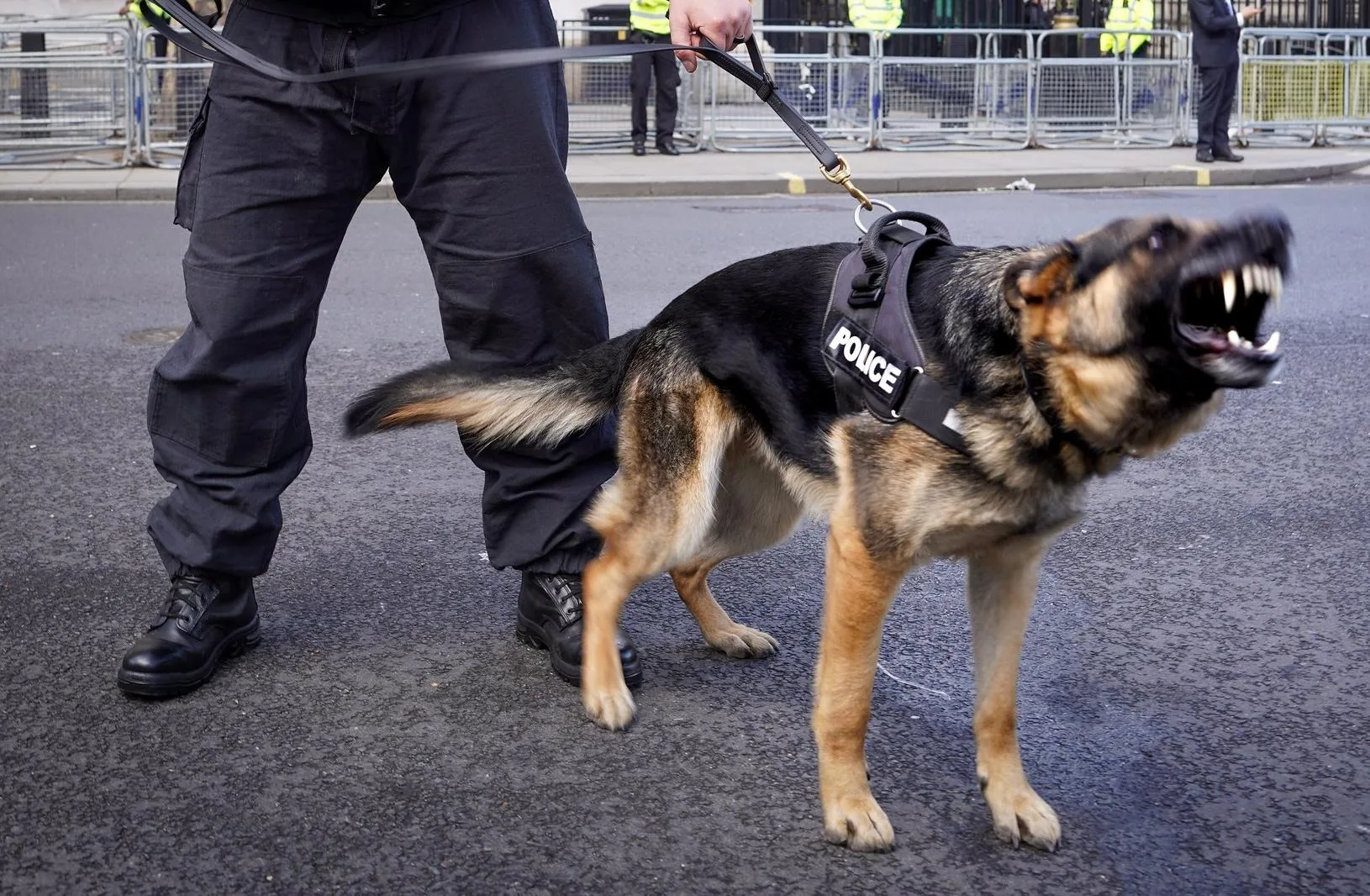Newsletter
U.S. Police Dogs Originated from Slavery—and Must Be Abolished
The Thirteenth Amendment bans all “badges and incidents” of slavery. But the use of police dogs enacts cruelty on both people of color and the dogs themselves. To fully rid society of slavery, the dogs must be retired.

The Thirteenth Amendment purported to abolish chattel slavery, along with what an 1883 Supreme Court decision called its “badges and incidents.” But the amendment left some infamous carve-outs: Namely, it remains legal to enslave people who have been convicted of a crime. But there is another remaining “badge and incident” of slavery that we must uproot: the police’s use of K9 units. The police’s practice of using dogs to attack human beings derives from enslavers’ practice of using slave hounds to attack enslaved people. This coercive history harms human beings and animals in order to perpetuate the racial and economic interests of people in power. One way we can honor the Thirteenth Amendment’s promise to rid our society of slavery—all of its badges and incidents—is by getting dogs out of policing.
State-sanctioned canine attacks–like those implemented by modern police canine units–were common in chattel slavery. Legal scholar Madalyn Wasilczuk speaks of how white enslavers “conceived of an enslaved person’s attempt to obtain freedom as a type of high-value property theft, appropriately recaptured with brute force.” The use of dog attacks to preserve enslavers’ economic interests was legal, and thus not a rare act committed by a few bigots. Wasilczuk explains that the Fugitive Slave Act of 1850 federally legalized slave patrols’ ability to seize slaves in free states, often accompanied by hunting dogs—and the act was later nicknamed “the Bloodhound Bill” as a result. Legal scholar Michael Swistara stresses that these dog attacks were intentionally gruesome. Swistara explains how, as early as the 1700s, records show enslavers “bred Cuban bloodhounds with the explicit purpose of raising them to enact violence against Black people” and “the scars of dog bites were so common that they” were physical badges of slavery, becoming “marks used to identify [Black] escapees in advertisements for rewards.”
In addition to the violence these dogs inflicted, the dogs themselves were also forced, nonconsenting partners. Swistara correctly argues that police dogs were and still are themselves subjugated under the carceral state as disposable weapons used to perpetuate racial and economic inequality. Slaveholders had to deliberately break the bond between humans and dogs, humanity’s best friend. To conscript dogs into Black people’s racial subjugation and make the animals feel animosity towards Black people, “enslavers trained dogs by forcing enslaved people to beat the dogs[…]while others arranged planned chases or commanded dogs to attack enslaved people who had been forced to secure themselves to trees.”
Furthering this divide, slaveholders would feed their dogs rich diets of meat while denying the same to enslaved people. The institution of slavery was so desperate to suppress any bonds between enslaved people and dogs that these states even made it illegal for enslaved people to have dogs, claiming dog ownership constituted weapon possession. Despite the fact that dogs had to be trained to recognize and attack Blackness as they could not detect inherent racial differences, many “white Southerners, including Thomas Jefferson, believed that Black people smelled, looked, felt, and tasted different such that their dogs could detect differences between races imperceptible to humans but objectively present.” As Wasilczuk aptly summarizes, ultimately, “in treating dogs’ perceptions of their handlers’ prejudices as innate, white Southerners employed their animals in the project of race- making and racialized subordination.” Dogs thereby became forced partners to state violence.
This forced collaboration with slave hounds developed into modern-day police K9 units. After the abolition of chattel slavery, Wasilczuk emphasizes that the state-sanctioned use of dogs to attack human beings did not become widespread again until the Civil Rights Movement of the 1960s. Some of the most recognizable iconography of the Civil Rights Movement includes pictures and videos of police directing German Shepherds to attack Black people—many of whom were children. Just as Black runaways from slavery threatened an unfair economic system, Black civil rights protestors who experienced police dog attacks threatened the unfair Jim Crow economic system.
The historical pattern of the state forcing animals to attack human beings for cruelty and profit continues today. According to a public records request, Houston Police Department officers reported siccing dogs onto 104 people in the 14 months between March 2022 and May 2023. At least 77 of the 104 people attacked by this single police department’s K9 unit were either charged with nonviolent offenses or nothing at all. A 2019 study that examined more than 32,000 emergency room visits caused by police dog attacks between 2005 and 2013 found that 42 percent of the victims were Black.
Additionally, the prison industrial complex—the web of companies that make money from policing, incarceration, and enslaving prisoners—includes a network of businesses that profit from people captured by police dogs who are then forced to work for pennies or no money at all.
Modern-day law enforcement subjects police dogs to cruel and coercive training using prong collars, choke chains, and pain compliance. These methods reinforce aggression by subjecting the dogs to pain with the promise the suffering will end if they bite someone. In a country that claims to love its dogs, police dogs are used as weapons, sacrificed in situations where they can be killed, left to die in hot patrol cars, and—if they survive their forced “service”—auctioned off per their property status. Though police dogs have “officer” status, this farcical designation does not obtain the dogs’ consent to “work” as police officers or risk their lives. Despite having prohibitions against animal cruelty, these laws don’t change the fact that these dogs (and all animals) are still legally “property” who are used and abused to serve the economic and racial interests of people in power.
And, contrary to public belief, dogs are not a “necessary” component of law enforcement. Police canines are actually not very good at what they do—studies have shown that drug-sniffing dogs often produce false positives, especially when searching outdoors or inside vehicles. Once police officers sic a dog on a human being, the dogs all too often do not respond to commands to stop biting, instead mauling people for minutes on end and tearing flesh once pulled away. Studies show that police dog bites are more serious than standard dog bites and more often result in hospitalization. While slave hounds were beaten into seeing Black people as threats, today’s dogs reflect the racist biases of their police handlers: In a 2011 investigation, the Chicago Tribune found that, in a three-year stretch, Chicago Police Department dogs failed to find drugs 73 percent of the time when they searched Latino drivers after a drug-sniffing dog alerted.
Well-funded propaganda campaigns starring cute police dog mascots, the Paw Patrol, and RoboDogs obscure the violent, coercive, and anti-Black truth about the practice of using dogs to attack human beings. It makes it difficult for lawyers to uphold the Thirteenth Amendment’s promise.
In order to successfully file a lawsuit over a given practice under the Thirteenth Amendment, Congress must first declare the procedure a “badge and incident” of slavery. Congress has labeled “racially motivated violence” as a badge and incident of slavery, giving lawyers and scholars the opportunity to highlight the racialized violence of state-sanctioned dog attacks. When Civil Rights Corps sued the Harris County Constable’s Office in February of 2023 for siccing a dog on a Black man while he laid on the ground with his arms outstretched, attorney Shirley LaVarco was able to make clear ties to the historical use of slave hounds in the South.
Abolishing the badges and incidents of chattel slavery means refusing to force human beings and animals to perpetuate the racial and economic interests of people in power. If we want to uphold the Thirteenth Amendment and everything it stands for, getting dogs out of policing is an important place to start.
Bina Ahmad is a former state and federal public defender, and currently senior attorney with Civil Rights Corps. In her professional and political work, she focuses on abolition, the criminal system, animal liberation and international human rights. She is the author of “Criminal Defense for Political Activists: A Lawyer’s Solidarity with the Movement,” and an article titled “The Professionalized Violence of Prosecutorial Power and Misconduct,” which will be published in the CUNY Law Review in 2024.
Kiah Duggins is an attorney at Civil Rights Corps who litigates alongside movements against police abuse and pretrial detention nationwide. Her writing about prison industrial complex abolition and international human rights can be found in the Harvard Civil Rights Civil Liberties Law Review.

In the News
Frozen embryos are ‘children’ according to a ruling from Alabama’s Supreme Court. Individuals can now be found liable for destroying frozen embryos which industry leaders fear could lead to the end of IVF in the state. [Alander Rocha / Alabama Reflector]
As part of a tough-on-crime push by Louisiana lawmakers, a new bill was introduced that could add nitrogen gas and electrocution to the state’s death penalty methods. Last month, Alabama executed Kevin Smith with nitrogen gas which left him gasping and convulsing for minutes. [Sara Cline / Associated Press]
Pennsylvania’s Supreme Court will reconsider whether life without parole for a man convicted of second-degree murder is constitutional. Lawyers for Derek Lee have argued that it is a cruel and unusual punishment for someone who lacked intent or even direct involvement in a killing. [Victoria Law / The Nation] & [Peter Hall / Pennsylvania Capital-Star]
Corrupt cops could be banned from continuing to work in Mississippi law enforcement. A new bill would give state authorities the power to both investigate and punish misconduct and is supported by both the Mississippi Sheriffs’ Association and the Mississippi Association of Chiefs of Police. [Brian Howey and Nate Rosenfield / Mississippi Today]
Chicago is ending its use of Shotspotter. The contract with the company that makes the troubled gunshot-detection technology expired last week and the city will stop using it after September. [Jim Daley / South Side Weekly]
